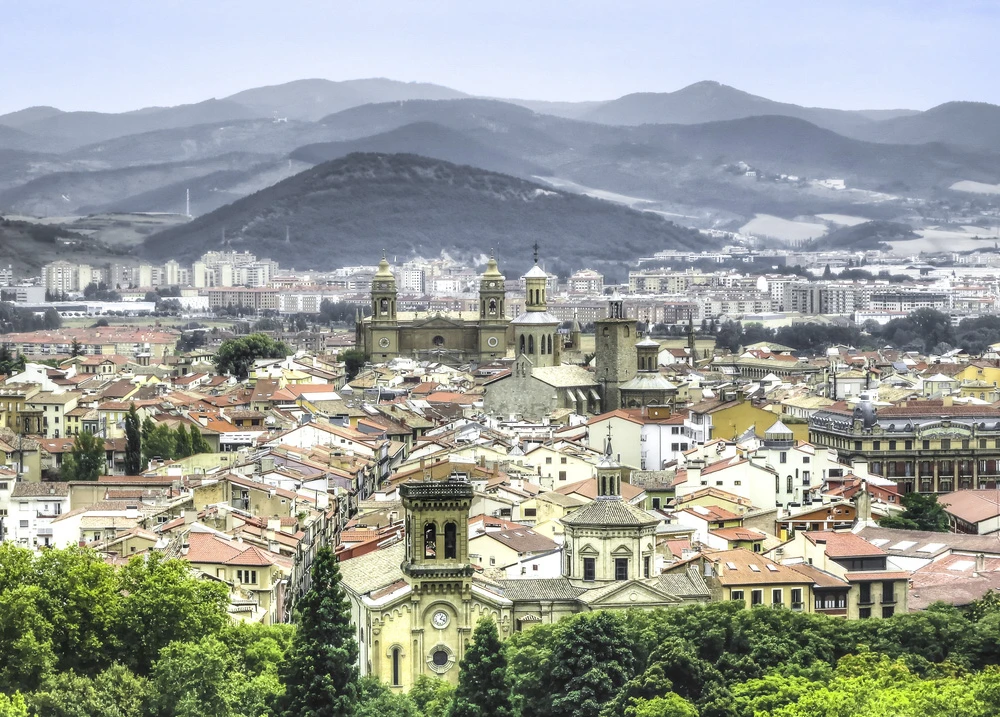The capital of Nafarroa Iruña, or Pamplona, is most famous for the running of the bulls. I had the interesting pleasure of attending the running, watching from the safe vantage point of a balcony. But, the city boasts a history of more than 2000 years and is first mentioned by the Romans. The importance of the city and the province to Basque history cannot be overstated. It was also a nexus of cultural intersection, with the Romans, the Arabs, the French, and the Castilians all vying for control at various points in history. But, at its heart, it has always been Basque.

- Iruña was first mentioned in ancient Roman texts. Roman geographer Strabo described a city between the Ebro river and the Pyrenees called Pompelon, the city of Pompey. Similarly, Ptolemy refers to Pompelon as one of the fifteen Basque towns. Clearly Pamplona was named after the Roman general Pompey, a result of his stay in the area in the winter of 75-74 BCE during his war against against Sertorius. However, the Basque version, Iruña, arises from the fact that this was a (perhaps the) major city for the Vascones. In Basque, Iruña means the city. The historic importance of the city and the region is reflected in the recent discovery of the Hand of Irulegi.
- The medieval city was built upon the foundations of the Roman city before it, and even a pre-Roman settlement before that. Because the modern city lies atop these, it is challenging to conduct detailed archeological studies.
- Iruña was at the heart of many conflicts between different tribes and kingdoms of Europe, including the Germans/Suebi, the Visigoths, and the Franks. The Visigoths conquered the city and the region during 466 to 472 and again, this time led by Liuvigild, in 581. In between, in 541, the Franks raided and took control of the city. Several times the city was ransacked and destroyed, only to be rebuilt. However, the local Vascones – the Basques – were on the outside looking in, trying multiple times to retake the city. One occupying monk described the city as enviable and always victorious city, it is surrounded by mountains and by “barbarous and enemy people,” against whom it is necessary to wage war without compassion. The Basques constantly fought against these invading peoples.
- In 711, the Umayyads, Muslim Arabs, began their conquest of Hispania, reaching Iruña a few years later. The city brokered a treaty and was subsequently ruled by the Arabs. The Banu Qasi dynasty including several Muslims that were of Basque decent. Abd al-Rahman al Gafequi made his headquarters in Iruña as he tried to further his invasion north. There were many intermarriages. For example, the widow of Eneko Jiménez and mother of Eneko Arista, considered the first king of Pamplona, joined Musa ben Fortún. They had a son – the great Musa ben Musa, brother of Eneko. Their marriage also coincided with Charlemagne‘s creation of the Kingdom of Aquitaine as a counterpoint to the Basques.
- The Arabs ruled the region until 755 when Yusuf al Fihri, the last governor of Al-Andalus, tried to quash Basque unrest and was defeated. In 778, Charlemagne moved south, trying to reconquer some of the Muslim-controlled lands. He tried to take Zaragoza but was repelled. In his retreat, he destroyed the walls of Iruña. In his retreat over the Pyrenees, the Basques exacted their revenge, as immortalized in the Song of Roland.
- The Kingdom of Pamplona, first led by Eneko Arista, was created sometime around 824. During this time, Iruña struggled. Its people were described by Muslim chroniclers as poor, malnourished, and dedicated to banditry. They supposedly spoke Basque, which “makes them incomprehensible.” In 905, Sancho I became king of Pamplona, ushering a new age.
Primary sources: Auñamendi Entziklopedia. Pamplona / Iruña. Historia. Auñamendi Encyclopedia. Available at: https://aunamendi.eusko-ikaskuntza.eus/en/pamplona-iruna-historia/ar-101822/; Pamplona, Wikipedia
Discover more from Buber's Basque Page
Subscribe to get the latest posts sent to your email.



Thanks for your research and sharing!
all this bloodshed!!! and yet, there is a Navarre and a Basse Navarre.
Monique